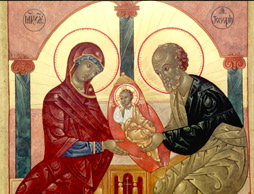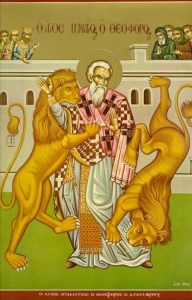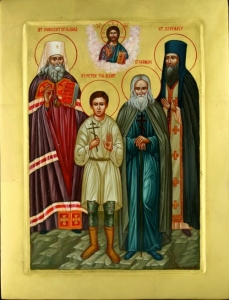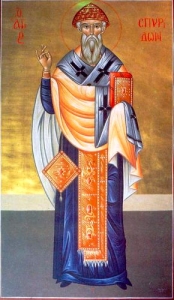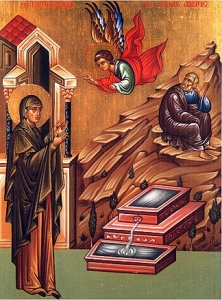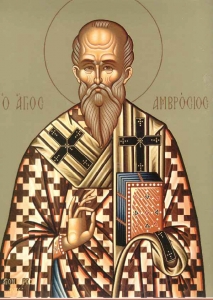
On this the fifth Sunday of Great Lent, we have an opportunity to learn from three different examples that the Church presents us, the Epistle, the Gospel reading, and the life of St. Mary of Egypt.
As a starting point let’s look at the last sentence of the Epistle reading (Hebrews. 9, 13). St. Paul ends this passage with the statement “Purify your conscience from dead works to serve the living God.” We might ask ourselves, what are ‘dead works?” For examples let’s first go to the Gospel reading of today (Mark 10, 32 – 45). Jesus tells His disciples exactly what is going to happen during His passion. James and John respond in a way that shows how much they don’t get it. They believe Jesus will be an earthly ruler and they want to share in His glory and His power. Their selfish desire is to have a position of prominence over the other disciples. Driven by their egos, they want to be first. In response to their desire to be the most important of the disciples, Jesus defines true leadership for them and for us. Christ replaces their “dead works” of ambition with what it is to truly live in Christ as a servant leader.
The next lesson that the Church presents to us today to help us purify our ‘dead works’ is the story of St. Mary of Egypt. We all know Mary’s story, her conversion from sinner to saint. Looking at her and her early life of degradation, we can see several lessons of “dead works.” No doubt, her lifestyle is a warning to us to not attach ourselves to the pleasures of this life, the pleasures that seduced Mary. There is also a much deeper lesson here for us. Think, what do we feel of when we look at the young Mary? We might say to ourselves – “what a sinner, she is beyond hope, I thank God I am not like her.” How can we point our finger and judge her? We see that God is not finished with Mary, but in our own mind we have already passed judgement on her!
As Mary’s life unfolds, we see the love of God and the prayers of the Theotokos bring her to repentance and to conversion. She destroys her dead works and becomes a model of contrition. Being prevented from entering the Church of the Holy Sepulcher by the force of her sins. Mary recognizes her wretchedness and asks for forgiveness and seeks redemption. After being freed to venerate Christ’s Holy Cross, she flees to the desert beyond the Jordan in obedience to the directions of the Theotokos. Here she finds her true self.
The life of Mary was documented for us by St. Sophronios, the Patriarch of Jerusalem in the seventh century. Sophronios introduces us to the Monk Zosimas, who is lead by God to travel to the desert in search of a holier monk to spiritually edify him. Zosimas journeys into the Jordanian wilderness and encounters a naked stranger. Without telling him her name, Mary recounts her life story. She confesses all her past sins leaving out nothing. She relates how she came to the desert lead by the instructions of the Theotokos. She informs him that she has struggled in the wasteland for 47 years. She tells the monk that for the first 17 years, she battled her demons of temptation; but how her heart was cleansed and purified by God’s love. As she speaks, Zosimas is profoundly affected by her humility and her holiness. Mary’s old life, all her “dead works,” have been purged away and Zosimas sees a soul truly alive in Christ. For us today during this period of “social isolation,” we are living isolated as did Mary. Isolated from everyone, Mary found God and God’s grace. What an opportunity we have to follow the lonely isolation that Mary’s example provides us.
Take a moment to look at the icon, it shows Abba Zosimas giving St. Mary Holy Communion. He returned, one year after their first encounter on Holy Thursday, as Mary had requested. He had not said anything about her to anyone. To his amazement, he witnessed a miracle, as this still unidentified woman, walked on the water and crossed the River Jordan so that she could receive the sacrament. The holy woman asks the monk to return again next year on that very same day to the spot they first met to again give her Holy Communion. Zosimas does as she asks, only to find the incorrupt body of the dead saint laying on the ground. Scratched in the sand beside her was a note asking the monk to bury and to pray for “Mary, the miserable sinner”. The note also said that she had died the very day she first received communion from his hands the year before. Zosimas marveled that Mary had traveled the journey of two days in only one hour and had then peacefully fallen asleep in the Lord. With the miraculous help of a wild lion, Zosimas buried body of the holy saint and returned to his monastery to relate her story. This is the story that was chronicled for us by St. Sophronios. There are many more details you can read for yourself in her life. But even now, close to the end of Great Lent and during our time of isolation, let us remember that Our Lord can heal our dead works of ego, ambition, pride and sinful living if we only turn to Him in sincere repentance. ….God Bless! dn g
]]>


